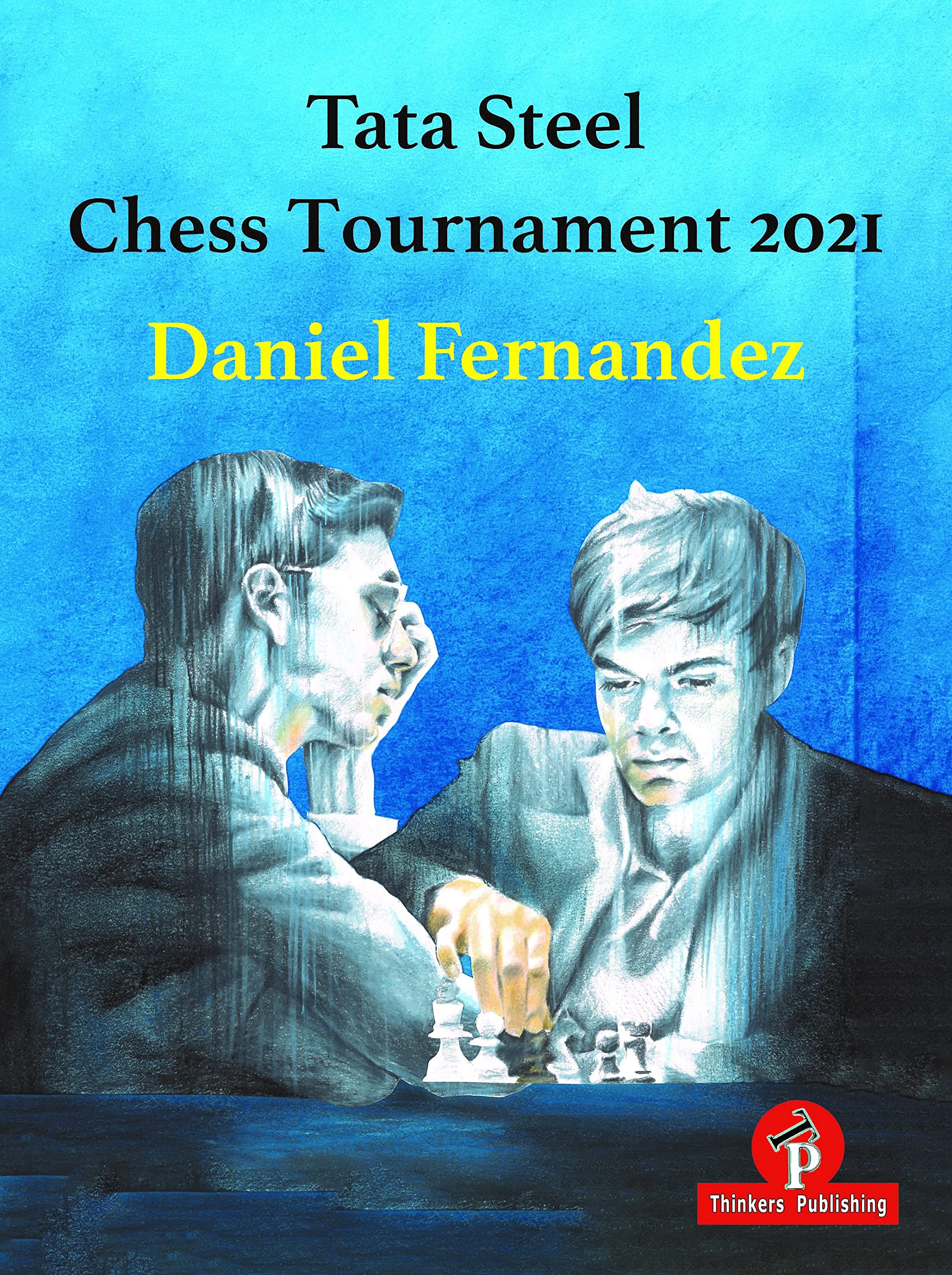
From the publishers’ blurb:
“That such a fine achievement should be immortalized, is beyond dispute. But who will pick up the gauntlet? We live in a volatile world where the Internet is dominant and when a tournament is over, the next one is already at the door. No time for reflection and historical awareness? Yet there was someone who had followed the tournament with great interest. The English grandmaster Daniel Fernandez, who also publishes for ChessPublishing came up with the idea of thoroughly examining all the games from this tournament. He did not take any chances in doing so. In addition to the various sources he found on the Internet, he of course used the strongest engines available at the moment. He also had engines in the cloud patiently calculate various positions. Together with his source research and his own insights, he has created a unique compilation of chess-technical material that is unprecedented.
In doing so, Fernandez has painted a fantastic picture of the opening variants that were on the board in this tournament. He has done a thorough research of the ins and outs of the various variants and placed them in a broader perspective. And it must be said that the organization was kind to him by providing an interesting field of players who gave it their all every round. This resulted in many nice confrontations with extremely interesting opening theory! That Fernandez did not get away with the middle game and the many fascinating endgames was clear from a first estimate of the amount of material when it had to be converted to the format of this book. Initially, we ended up with almost 900 pages! That is far too much and therefore drastic cuts had to be made. Hundreds of (analysis) diagrams have been dropped, small side notes are no longer in the book and sometimes – pain in the heart – the trees of variations had to be cut back. That only happened, by the way, when the ingenious structure became so extensive that it would be hard to follow for “mere mortals”. It is being considered whether this can be made available digitally at a later date, and the moment that it is, we will of course put Fernandez’s entire analytical work on offer! IM Herman Grooten, December 2021 ”
GM Daniel Fernandez (born 1995) is an English grandmaster with a slightly unusual approach to chess: at once mischievous and hardworking, and equally comfortable in tactical positions or dry endgames. His style fits the Modern perfectly and he has played it with success for almost a decade. He is a past holder of the British under-18 and under-21 titles, and the winner (or joint winner) of many open tournaments, such as Paracin 2017, Pula 2018, Ghent 2019 and the New Zealand Open 2020. Daniel also writes and commentates frequently, and is a columnist of the 1.e4 section on ChessPublishing.com. This is his third book for Thinkers Publishing, the Modernized Caro-Kann and Modern Defense were his first two and world wide acclaimed as the best you can get.

Chess book collectors will look back with fondness on the days when competitions between leading players were often commemorated by tournament books. Hastings 1895. New York 1924. The 1953 Candidates’ Tournament. Everyone with a passion for chess literature will have books such as these on their shelves. From time to time they’ll open them again, not just to admire the games but to relive the excitement of the event. Like me, they’ll regret that this tradition seems to have gone out of fashion.
Is this book a worthy addition to an almost forgotten genre of chess literature?
With 750 pages, trimmed down from an original almost 900, one can only admire Daniel Fernandez’s industry in compiling the book, in producing several pages of detailed analysis, often focused on modern opening theory, for almost every one of the 91, invariably hard-fought games produced by some of today’s leading Grandmasters.
The author has made an unexpected and seemingly unexplained decision in ordering the games by the player of the white pieces. So we start with all the White games of Alexander Donchenko, who eventually brought up the rear, through to those of Jorden van Foreest, the rather unexpected tournament winner.
I guess this makes sense if the main reason you’re reading the book is to study you heroes’ opening repertoires, but from my perspective as a humble club player it seems rather eccentric. Why not group the games by the player of the black pieces instead? Or, better still, why not group them by opening so that we can see all the Sicilian Defence, for example, games together? If, like me, you’re not especially interested in opening theory, you’d probably prefer a more conventional format, especially given that the book also includes the round summaries taken from a Dutch chess news website. So we get a Round 1 report, Donchenko’s white games, a Round 2 report, MVL’s white games and so on, which creates, at least for me, a rather disjoined effect.
The opening analysis is, for many games, extremely detailed. Take, for example, Esipenko’s win over Carlsen in round 8. We get five pages of notes about the latest trends in the Sicilian Najdorf, which I’m sure is deeply fascinating to anyone playing that opening with either colour at master level, but of only passing interest to someone like me who finds the opening far too difficult for comfort.
Esipenko sacrificed a pawn in the opening, reaching this position where he gained a winning advantage: 18. Ncxb5+ axb5 19. Nxc6 Qxc6 20. Qc3: a familiar enough sacrifice but with an unusual follow-up. The queen fork regains the piece and the World Champion eventually succumbed.
50 or more years ago, when I was young and innocent enough to look at opening theory, the Sicilian Najdorf was all the rage. It’s still popular now, although most of it looks very different from the days when we eagerly awaited the news of Bobby’s latest games. One line that’s still popular, and hasn’t changed all that much, is the Poisoned Pawn variation. To the best of my knowledge it’s still, in general, standing up well for Black, but it’s very easy to go wrong and lose quickly, as MVL found out against Caruana.
Black plumped for the wrong pawn capture on d5, and now White continued 14. e6!! A crushing breakthrough. After 14 moves Black is essentially lost against good play!, according to Fernandez, who provides some beautiful variations against various Black tries here.
As you’d expect, the tournament produced its fair share of fascinating endings. I found this position, from Wojtaszek – Anton Guijarro, particularly instructive.
Here Black played 58… Rg1!. Fernandez comments: Black shows alertness and does not allow the half-point to slip away. There are only a few dangers for Black in this position, and foremost among them would be allowing the enemy king into f6. Hence 58… Ra2?? loses, because Black now has to go very passive to prevent the infiltration.
He then goes on to give a lot of analysis demonstrating how White can always, at worst, reach the Lucena position.
The analysis of the remaining moves (59. Rb7 f6 60. e6 and so on) is also informative as to how this very typical position should be played.
At one level this is a magnificent, monumental book. You get 91 top level games, all deeply annotated, all hard fought, with profound opening play, often exciting middlegames and sometimes intricate endings. Fernandez has put in an enormous amount of work to ensure that readers are informed about the latest opening theory in lines currently popular at top GM level (although I guess it’s all 18 months out of date now!), and that all the analysis has been thoroughly checked for accuracy using the most powerful engines. The production values are high, with many excellent photographs and lots of interesting background material. I spotted a few typos, but not enough to spoil the book.
And yet, writing as a fairly strong club player, it’s sadly not a book for me. It’s just much too heavy, in more ways than one. Picking it up made my arms hurt and reading it made my brain hurt.
Give me a 250-300 page tournament book rather than 750 pages, and I’d be happy. I’d want the games in round order, annotated in a user-friendly (but not patronising) way, with opening theory and computer-generated variations only included where necessary, with helpful tips on how I could learn and improve my game and perhaps some reader interaction such as quiz questions. Indexes of openings and endings would also be welcome.
If you’re an ambitious 2200+ player, this book will, I’m sure, be ideal for you. If, like me, you’re an unambitious under 2000 player, you may well think it’s too much of a good thing.
I sometimes get the impression that there are a number of grandmasters who write books for themselves and their friends rather than considering the nature of their target market. For me this book, praiseworthy and outstanding though it undoubtedly is, falls into that category.
I’d advise you to make up your own mind whether this is a book for you. If you click here you’ll be able to download a teaser.
Richard James, Twickenham 28th June 2022

Book Details :
- Softcover: 750 pages
- Publisher: Thinkers Publishing; 1st edition (14 Feb. 2022)
- Language: English
- ISBN-10: 9464201428
- ISBN-13:978-9464201420
- Product Dimensions: 17.02 x 4.57 x 23.62 cm
Official web site of Thinkers Publishing

